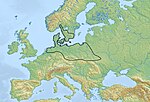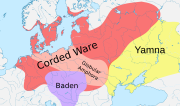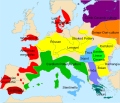The Corded Ware culture is considered to be a likely vector for the spread of many of the Indo-European languages in Europe and Asia. The term Corded Ware...
78 KB (9,104 words) - 22:28, 16 November 2024
Beaker culture was partly preceded by and contemporaneous with the Corded Ware culture, and in north-central Europe preceded by the Funnelbeaker culture. The...
166 KB (19,275 words) - 22:39, 16 November 2024
2800 BC – c. 2300 BC. It was an offshoot of the Corded Ware culture, and replaced the Funnelbeaker culture in southern Scandinavia, probably through a process...
20 KB (2,476 words) - 13:25, 2 May 2024
culture in Estonia shows some evidence of agriculture. Some of this region was absorbed by the later Corded Ware horizon. The Pit–Comb Ware culture is...
11 KB (1,173 words) - 16:17, 9 May 2024
from the nearby Corded Ware culture. This makes it unlikely that the Corded Ware culture can be directly descended from the Yamnaya culture, at least along...
68 KB (7,046 words) - 22:53, 22 November 2024
as the Aryans, the Sintashta culture is thought to represent an eastward migration of peoples from the Corded Ware culture. The earliest known chariots...
46 KB (4,908 words) - 14:33, 20 October 2024
Corded Ware culture in its central area. Somewhat to the south and west, it was bordered by the Baden culture. To the northeast was the Narva culture...
11 KB (1,250 words) - 12:44, 21 October 2024
incorporated into the Corded Ware culture through intermixing with incoming Corded Ware males, and that people of the Corded Ware culture continued to use...
38 KB (3,931 words) - 16:10, 21 October 2024
ceramics show mixed Corded Ware/Globular Amphorae traits. The later Abashevo culture pottery looked somewhat like Fatyanovo-Balanovo Corded Ware. Settlements...
24 KB (2,795 words) - 21:24, 31 October 2024
that the Andronovo culture and the preceding Sintashta culture were derived from an eastern migration of the Corded Ware culture, given the higher proportion...
64 KB (7,134 words) - 04:43, 25 November 2024
such as the ancient individuals of the Corded Ware and Bell beaker cultures. In the eastern Corded Ware culture, the Fatyanovo-Balanovo group may have...
56 KB (6,144 words) - 15:53, 16 November 2024
southern Scandinavia. Both were variants of the Corded Ware culture. Like the Funnelbeakers, the Corded Ware constructed a series of defensive palisades during...
27 KB (3,211 words) - 19:24, 12 August 2024
and described the Narva culture. At first, it was believed that Narva culture ended with the appearance of the Corded Ware culture. However, newer research...
11 KB (1,212 words) - 05:21, 3 April 2024
the Corded Ware culture. Slavic and Baltic developed at the middle Dniepr (present-day Ukraine) at c. 2800 BCE, also spreading with the Corded Ware horizon...
267 KB (29,498 words) - 03:16, 21 November 2024
in the Fatyanovo–Balanovo culture, an eastern offshoot of the Corded Ware culture of Central Europe, the Abashevo culture is notable for its metallurgical...
25 KB (2,936 words) - 00:38, 21 November 2024
sometimes known as the Grooved ware people. Unlike the later Beaker ware, Grooved culture was not an import from the continent but seems to have developed...
4 KB (628 words) - 00:55, 9 September 2024
Proto-Indo-Europeans (category Neolithic cultures)
the north of Europe (Corded Ware culture), the edges of Central Asia (Yamnaya culture), and southern Siberia (Afanasievo culture). In the words of philologist...
54 KB (6,411 words) - 09:32, 18 September 2024
questioned. The Single Grave culture was an offshoot of the Corded Ware culture, which was itself an offshoot of the Yamnaya culture of the Pontic–Caspian steppe...
17 KB (1,904 words) - 18:26, 15 November 2024
Mierzanowice culture. The individuals appeared to be closely related to peoples of the Corded Ware culture, Bell Beaker culture, Unetice culture, and the...
9 KB (939 words) - 06:40, 7 October 2024
origin of R1a1a in the Corded Ware culture, noting that several publications point to the presence of R1a1 in the Comb Ware culture. Kivisild et al. (2003)...
164 KB (13,140 words) - 08:50, 17 October 2024
Corded Ware culture, and the Yamnaya horizon, in contrast to larger genetic differentiation between populations associated with western Corded Ware culture...
49 KB (5,072 words) - 22:24, 19 November 2024
contemporaneous with the late Funnelbeaker culture, the Globular Amphora culture and the early Corded Ware culture. The following phases are known: Balaton-Lasinya...
13 KB (1,202 words) - 13:20, 4 May 2024
romanized: Siaredniedniaproûskaja kuĺtura) is a formative early expression of the Corded Ware culture, ca. 2800–1800 BC, of northern Ukraine and Belarus. As the name indicates...
5 KB (551 words) - 17:50, 2 November 2024
county, Hungary. It was preceded by the Linear Pottery culture and succeeded by the Corded Ware culture. In its northern extent, overlapped the somewhat later...
11 KB (812 words) - 16:14, 3 August 2024
Archaeology of Northern Europe (category Archaeological cultures of Europe)
characterized by the Funnelbeaker culture in the 4th millennium BC. The Chalcolithic is marked by the arrival of the Corded Ware culture, possibly the first influence...
24 KB (2,554 words) - 14:48, 25 November 2024
Neolithic European cultures. However, the exact genetic relationship between the Yamnaya culture, Corded Ware culture and Sinthasta culture remains unclear...
25 KB (2,726 words) - 01:07, 11 November 2024
closely related to peoples of the earlier Yamnaya culture, Bell Beaker culture and Corded Ware culture. Their amount of steppe-related ancestry is comparable...
78 KB (8,275 words) - 17:04, 13 November 2024
about 2200 BC is characterized by the appearance of the Corded Ware culture, pottery with corded decoration and well-polished stone axes (s.c. boat-shape...
16 KB (2,038 words) - 15:01, 25 October 2024
culture and the Funnel beaker culture seem clearly distinguishable from one another. When the Funnel beaker culture ceased to exist, the Corded Ware culture...
3 KB (320 words) - 12:29, 14 May 2024
existed among the Komarov people. The Komarov culture is believed to have originated within the Corded Ware horizon, with which is shares numerous similarities...
2 KB (193 words) - 15:00, 1 November 2024


























